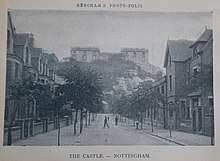Ulmus × hollandica 'Nottingham'
Ulmus × hollandica 'Nottingham' is an elm cultivar. It was distributed from the early nineteenth century as 'Siberian elm' by Castle Nurseries, Nottingham, and much planted locally.[1][2] Richens (1983) described it as a hybrid, possibly of French origin, between wych elm Ulmus glabra and field elm Ulmus minor. He called it Nottingham elm.[3]
| Ulmus × hollandica 'Nottingham' | |
|---|---|
 Nottingham elms in Hope Drive, The Park, Nottingham, c.1900 | |
| Hybrid parentage | U. glabra × U. minor |
| Cultivar | 'Nottingham' |
Not to be confused with Downton elm, another hybrid cultivar from Nottinghamshire.
Description
The Gardeners' Chronicle (1855) described the cultivar as a vigorous and graceful tree, resembling some of the pendulous elms seen in the eastern counties of England. When young the bark was "almost as smooth as beech", and "the shoot so slender that [the tree] gives one the idea of being a slow-grower; yet it is a plant of enormous growth". The tree was said not to sucker, so did not require grafting. It was propagated by cuttings, which struck almost as readily as those of Lombardy poplar.[1]

No herbarium specimen of Nottingham Elm is known. As the only uncommon British horticultural elm dealt with by Richens (1983) (he ignored such cultivars as Scampston, Downton, Blandford, and Kidbrook), a specimen of its leaves may be among his unsorted all-England collection at the Cambridge University Herbarium in the Sainsbury Laboratory.[4]
Pests and diseases
Hybrid elms of this group are susceptible to Dutch elm disease.
Cultivation
In the mid-19th century the cultivar was present in the park of Highfield House Observatory, home of botanist and astronomer Edward Joseph Lowe (now part of University Park, Nottingham). It alternated with 'Canadian Giant' in an avenue at Chilwell Hall,[5] where it grew twice as quickly as 'Giant'.[1] When Nottingham Park below Nottingham Castle (also known as The Park, Nottingham, now The Park Estate) was turned into a residential area with large houses and gardens, 'Siberian elms' from Castle Nurseries "were freely planted from 1855 along the newly laid out roads, the earliest to be planted being those in Tunnel Road, which got a start of their neighbours".[2] In 1930 local historian J. Holland Walker attributed the "present leafy condition of The Park" to this 1850s' planting of the Castle Nurseries clone.[2][6] The tree is not known to have been planted outside the Nottingham area.[7][8][9][10] No specimens are known to survive.
References
- "A.B.", 'Nottingham Elms', The Gardeners' Chronicle and Agricultural Gazette, 1855, no.13; 31 March 1855, p.206
- J. Holland Walker, 'An Itinerary of Nottingham: Nottingham Park', Transactions of the Thoroton Society 1930, vol.34, p.1-52
- Richens, R. H., Elm (Cambridge 1983), p.97, p.196
- Richens, R. H., Elm (Cambridge 1983), Preface p.xi
- Chilwell, nottshistory.org.uk
- 'Nottingham Elm' in The Park, Nottingham, c.1890; francisfrith.com
- Nottingham Arboretum, 1920; francisfrith.com
- Nottingham University, 1928; francisfrith.com
- Old Castle Gateway, Nottingham; francisfrith.com
- Nottingham Castle, c.1890; francisfrith.com